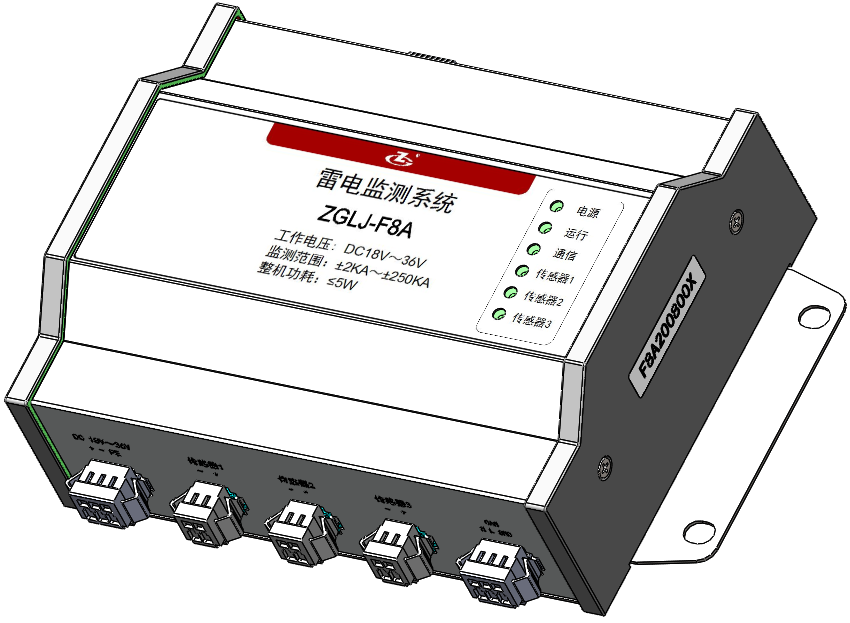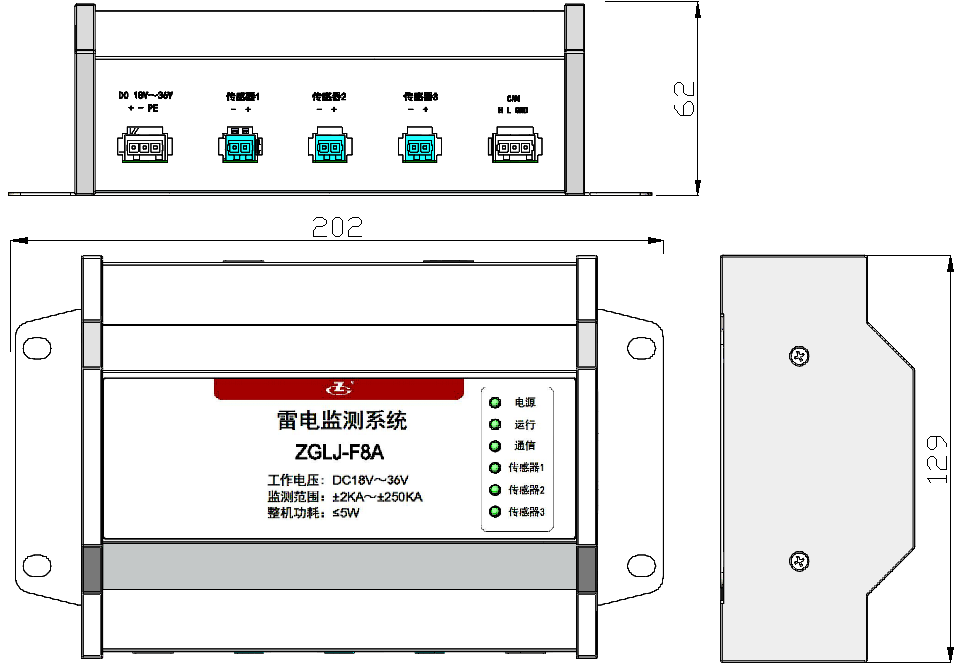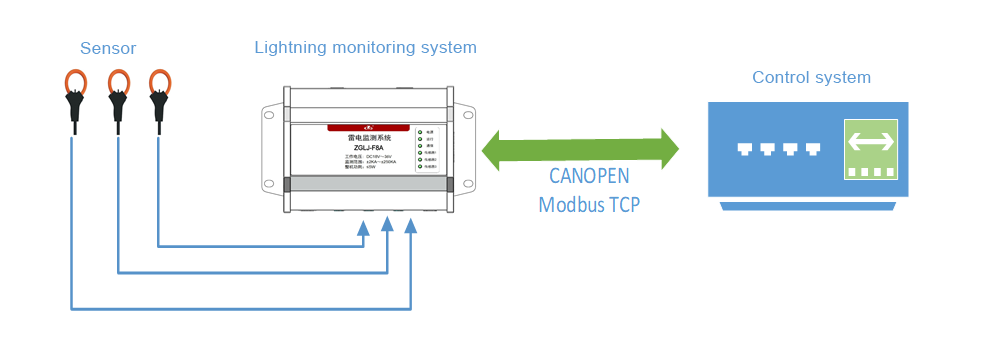ZGLJ-F8A

General
The system can monitor the lightning current information of wind turbine blades subjected to lightning strikes in real time and accurately.
The system consists of the lightning current sensor installed in the blades and hubs, lightning monitor, and lightning data management software for the monitoring center.
Operating Environment
| Power supply |
DC 18 V~36 V |
| Temperature |
-40 ℃~70 ℃ |
| Relative humidity |
≤ 95 % |
| Atmospheric pressure and altitude |
86 kPa~106 kPa |
Product Configuration (Standard Configuration)
| Name |
Quantity |
| ZGLJ-F8A lightning monitor |
1 |
| Lightning current sensor |
3 |
Performance Index
| Item |
Index |
| Monitored object |
Lightning occurrence time, peak value, polarity and times |
| Number of monitoring channels |
3 |
| Monitoring range of lightning peaks |
± 2 kA ~ ± 250 kA (Extended range: ± 200A~± 250 KA) |
| Measuring error |
≤ ±10 kA:≤ ±10 % |
| > ±10 kA:≤ ± 5% |
| Sensor frequency response |
1 Hz ~ 2 MHz |
| Storage capacity |
≥ 1000 alarm records |
| Communication interface |
Ethernet/CAN (reserved RS485)/RS232 |
| Communication protocol |
MODBUS TCP/CANOPEN (reserved Modbus RTU) |
| Waterproofing grade |
IP 20 |
| Overall power consumption |
≤ 5 W |
| Weight |
≤ 1 kG |
Standards Complied
Q/75875187-9·7—2016 Lightning monitoring system
GB/T 16927.4—2014 High voltage and high current test technology-Part 4: Definitions and requirements for test currents and measuring systems
GB/T 21714.1-2015 Protection against lightning- Part 1: General principles
Configuration
Working Principle
As the highest-position component in a wind turbine, the blade is the primary target of lightning strikes, and also is the most expensive component of the wind turbine, so the lightning protection is critical. In most cases, the location of the lightning strike is on the back of the blade tip. Currently, most of the blades are equipped with a special lightning protection system, which consists of a lightning receptor and a lightning conduction part. Inside the blade, the lightning conduction part directs lightning from the lightning receptor into the metal flange at the root of the blade and through the hub to the engine room. The protection of the gap discharge at the flange of the hub rapidly transmits the lightning current to the base of the engine room and releases the lightning overvoltage.
The lightning monitoring system can accurately sense the lightning current signal of the wind turbine blade subjected to lightning strike in real time and send it to the lightning monitor through the lightning current sensor installed in the fan blade. The lightning monitor will collect, calculate, and record the lightning strike time, frequency, peak value and polarity of lightning current and store them in the internal memory.
The lightning monitoring system is installed in the hub control cabinet, with CAN or RS485 communication interface, implements CANOPEN or Modbus RTU protocol. The monitoring data is transmitted to the control system in the hub through this interface. Then it is transmitted to the monitoring center together with the monitoring data of the control system. By the wind farm centralized monitoring system, data display, management, statistics and reports are realized. The principle block diagram is shown as follows:
Note: The communication interface can be customized on user’s requirement.
Functional Characteristics
4.1Real-time monitoring of lightning strike failures
Multi-channel real-time recording of lightning occurrence time, lightning current peak value and polarity.
Large-capacity data storage
Up to 1000 data records.
With data save in case of power failure, long-term monitoring can be realized to avoid data loss.
Equipment status monitoring
With equipment working status and key parameter monitoring, including sensor connection status, acquisition channel status, communication status, equipment working temperature and other status and parameters in real time, with regular equipment self-checking function to ensure the effectiveness of equipment work.
Setting of working parameters
With equipment working parameter setting function, including trigger threshold, temperature collection time interval, self-check time interval and other parameter settings.
High-precision sensing technology
The non-contact high-precision transient current sensor is used for wide-band signal response, which can effectively sense the lightning signal.
High reliability
The requirements of GB/T 3783 are met, with strong anti-interference ability.
Built-in hardware watchdog circuit, so crash is never going to happen.
Imported anti-loose connector is used to ensure reliable connection under the vibration environment of the fan.
Power, signal and communication ports have surge protection functions to ensure reliable operation of the equipment.
Data statistics and analysis
Lightning data management software can realize the storage, analysis, and statistics of lightning data of the wind turbine; the effectiveness of lightning protection facilities is evaluated, to provide a basis for lightning protection design and reconstruction in the area.
Lightning Management Software
The lightning data management software is a kind of management software specially developed for the functions of lightning monitoring system setting, data downloading, management, reporting, printing, etc. It can support the digitization and paperless management, analysis and processing of lightning monitoring information.
The lightning data management software displays the distribution trend of time and density of lightning damage on the wind turbine in various ways such as data, graphs and tables, and realizes real-time monitoring of the lightning damage condition of the wind turbine within the monitoring range. Macroscopic statistics on the lightning strikes of wind farms, and analysis and judgment of the lightning damage conditions of wind turbines can be convenient for evaluation of the effects of lightning protection facilities for wind turbines, providing a basis for the lightning protection design, reconstruction and insurance claims in the area, to ensure the safe operation of wind turbine.




